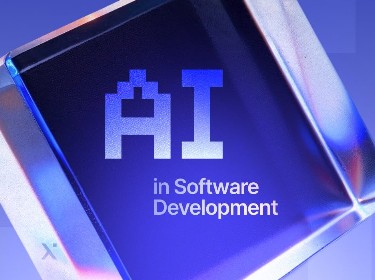We’ve collected 80 AI statistics from various segments, ranging from business impact to data across diverse industries, to provide you with a comprehensive understanding of the technology’s impact.
Due to its rapid evolution, AI holds the potential to shape the future of every industry and business segment. As technology advances, companies are discovering new ways to innovate and expand. But how swift is this technology adoption?
Below, you will find AI statistics that illuminate the impact of AI in 2025 and beyond.
AI market size and adoption rates
Although AI has been on the market for a while, ChatGPT’s public release in November 2022 marked a turning point, significantly boosting the technology’s mainstream adoption. This event resulted in a broader acceptance and interest in artificial intelligence.
- According to Grand View Research, the global artificial intelligence market is projected to grow to $1,811.75 billion by 2030, with an anticipated CAGR of 37.3% between 2023 and 2030.
- According to GlobalData, the worldwide market for generative AI stood at $1.75 billion in 2022 and is set to expand at a CAGR of 79.96%, reaching $33.03 billion by 2027.
- Spherical Insights estimates that the global market for artificial intelligence in computer visionis projected to hit$100.42 billion by 2032.
- The World Economic Forum research revealed that more than 75% of companies are planning to adopt AI, big data, and cloud computing in the next five years.
- More than 85% of surveyed businesses pinpoint the expanded adoption of emerging technologies and the widening of digital access as the key trends poised to drive transformation within their organizations.
- In a recent survey by Gartner, Inc., involving over 2,500 executive leaders, 70% of organizations said they are currently exploring generative AI, with another 19% stating they are in the pilot or production stage.
- According to Forrester, over a quarter of global AI decision-makers anticipate that between 51% and 75% of their workforce will be utilizing generative AI technology by the end of 2025.
- The adoption of AI continues to hold steady, with 55% of respondents confirming that their organizations have embraced AI technology, according to McKinsey. However, less than a third of these participants indicate that AI is being utilized in multiple business functions, implying a limited scope in its application.
- In 2023, the average AI deal size has increased by 48% year-to-date, driven by mega-rounds.
- The worldwide market for AI Voice Generators, valued at $1,396 million in revenue in 2023, is projected to rise to $4,889 million by 2032. This growth represents a CAGR of 15.40% from 2022 to 2032.
![]()
Sources for further reading:
Explore recent statistics, trends, and the application landscape of generative AI
AI business impact
AI continues gaining traction across organizations worldwide. Moreover, the recent emphasis on generative AI is contributing to its broader adoption by business leaders.
- Organizations emphasizing AI at the core of their operating models have seen enhanced performance metrics. Notably, these entities surpass their competition 44% more often compared to those concentrating merely on skills.
- According to the World Economic Forum, generative AI has received particular attention recently, sparking discussions around its potential to automate over 50% of tasks for 19% of the workforce.
- Employees foresee a structural shift in the labor market, with 23% of jobs expected to undergo churn over the next five years due to the interplay of emerging jobs and elimination of declining ones.
- Employees anticipate that 44% of workers’ skills are set to face disruption within the five-year period.
- Advancements like generative AI can change the landscape of automatable tasks over the 2023-2027 period, as studies suggest Large Language Models could automate 15% of tasks, potentially rising to 50% with applications addressing current model limitations.
- Bloomberg estimates that increasing demand for generative AI products could result in adding about $280 billion of new software revenue.
- BI forecasts generative AI’s reach to grow from under 1% to 10% of the total market in IT hardware, software services, ad spending, and gaming by 2032. Key revenue contributors include generative AI infrastructure services, projected at $247 billion, digital ads at $192 billion, and AI assistant software at $89 billion.
- PwC forecasts that labor productivity enhancements are expected to account for over 55% of the overall GDP gains from AI between 2017-2030.
- By 2025, AIOps is set to be the new standard in IT operations, with a minimum of 50% of large enterprises expected to embrace AIOps solutions for automating key IT system and service management processes.
- 97% of executives worldwide agree that foundational AI models will facilitate connections across various data types, transforming the utilization and application of AI.
- In a Skynova survey of 1,000 successful small-business owners, 9 out of 10 confirmed that using AI was essential for their business growth, with adopters seeing a 75% revenue increase compared to those that have not embraced this technology.
![]()
Sources for further reading:
We can seamlessly integrate ML models into your business workflows. Contact us to discuss it
AI impact on users and consumers
Most consumers are notably open to embracing artificial intelligence in various facets of their lives. The willingness to adapt to this technology stems from AI’s potential to simplify tasks, enhance personalized experiences, and automate time-consuming activities.
- According to a survey by Forbes Advisor, consumers envision numerous applications of AI, including assisting with tasks such as replying to emails from friends or colleagues (45%), getting answers to financial queries (43%), putting together travel itineraries (38%), writing emails (31%), preparing for job interviews (30%), crafting social media posts (25%), and breaking down complex or lengthy information (19%). However, 11% of the respondents said that they weren’t inclined to use AI for any particular reason.
- In the same survey, 55% of respondents were okay with AI analyzing their social media habits, while 48% accepted its scrutiny of their past purchases, driving patterns, and destinations. Consumers were also open to AI evaluating the movies and shows they watch (45%) and the music they enjoy (41%). However, they were less inclined to let AI assess their text messages (33%) and phone calls (21%).
- Salesforce found that although 73% of business buyers and 51% of consumers are open to using AI to enhance their experiences, these numbers have markedly decreased compared to the 2022 survey, which showed figures of 82% and 65%, respectively. Companies can bridge this gap by establishing ethical standards and offering clearer insights into the technology’s application.
- Almost half of the general population engages with generative AI, with over a third utilizing it daily. While 52% of these users report a rise in their AI usage, half of the population has never used it.
- A YouGov poll revealed variations among American demographic groups regarding AI’s impact on society. 37% foresee AI’s societal effects as entirely or mostly negative compared to 21% of those who anticipate them as entirely or mostly positive. Meanwhile, 27% predict that the impact will be equally positive and negative.
- Around 43% of professionals have employed AI tools, ChatGPT included, for tasks related to their work. Interestingly, nearly 70% of these individuals are utilizing this technology without their boss’ knowledge.
- It is projected that more than 65% of users would use ChatGPT instead of search engines.
![]()
Sources for further reading:
Salesforce press release
AI usage statistics
As the emerging data indicates, AI has the potential to significantly influence virtually every industry sector in the near future, bringing efficiency and automation.
- AI technologies could deliver up to $1 trillion of added value annually, with enhanced customer service contributing significantly to this figure.
- Tech companies are expected to witness the most substantial impact from generative AI, potentially adding value up to 9% of global industry revenue. Similarly, knowledge-intensive sectors like banking, pharmaceuticals, and medical products could see up to a 5% increase, and education up to 4%, marking significant shifts due to AI integration.
- By 2025, the number of data analysts and scientists adopting AutoML for the entire machine learning pipeline, spanning data preparation to model deployment, is expected to triple.
- By 2025, 50% of knowledge workers will routinely engage with their personal AI-enhanced robotic assistants, aiding in identifying and prioritizing tasks, gathering information, and automating monotonous work.
- Accenture discovered that in all industries, Large Language Models (LLMs) like GPT-4 have the potential to influence 40% of total working hours.
- The BFSI sector, healthcare, retail, government, and IT stand out as the top industry verticals, contributing a major portion to the overall AI market.
![]()
Sources for further reading:
We developed an AI tool that diagnoses retina diseases using input images. Find out how
AI statistics in retail
Current AI statistics indicate a growing demand for AI in the retail sector. This trend is driven by AI-powered applications that enhance customer experience through personalized recommendations, intelligent product search capabilities, and advanced pricing algorithms.
- By 2033, the adoption of artificial intelligence in the retail sector is projected to exceed a value of $127.09 billion.
- Between 2023 and 2033, the demand for artificial intelligence in retail is anticipated to grow at a CAGR of 28%.
- North America is set to dominate the AI retail market. It is projected that the United States will see a 5.8% CAGR in this sector during the forecast period, culminating in a market value of $64 billion by 2033.
- The market for artificial intelligence in retail is expected to grow at a CAGR of 30.5 percent between 2021 and 2028.
Sources for further reading:
AI statistics in real estate
Artificial Intelligence in real estate offers benefits to everyone involved, including professionals, buyers, and tenants. Below are the real estate AI statistics to help you better understand the landscape.
- The AI real estate market size is projected to grow from $164.96 billion in 2023 to $226.71 billion in 2025, representing a CAGR of 37.4%. This growth is attributable to advancements in market forecasting, property prediction, virtual assistants, enhanced property search, and automated property management.
- The global generative AI in the real estate market is expected to reach approximately $1,047 million by 2032, with an 11.52% CAGR from 2023 to 2032.
- AI could potentially generate from $110 billion to $180 billion in value for the real estate sector.
- Based on McKinsey’s analysis, in their experience with AI implementation, real estate firms have achieved an increase of over 10 percent in net operating income. This is due to improvements in operating efficiency, customer experience, tenant retention, new revenue sources, and smarter asset selection.
- Cloud-based generative AI is the dominant deployment mode in the market, accounting for 59% of usage compared to on-premises solutions. This is primarily because cloud-based solutions offer the flexibility of being accessible from any location with an internet connection, enabling realtors to use generative AI applications and tools on various devices.
Sources for further reading:
AI statistics in banking and finance
- AI implementations could potentially save banks $447 billion by the end of 2023, with AI advancements in the front and middle office potentially accounting for over 90% of these savings.
- The global market for generative AI in banking and finance was valued at $712.4 million in 2022 and is projected to expand to approximately $12,337.87 million by 2032. This growth represents a CAGR of 33% from 2023 to 2032.
- The U.S. generative AI in banking and finance market size stood at $244.48 million in 2023 and is anticipated to grow to $3,183.44 million by 2032. This represents a CAGR of 33% from 2023 to 2032. North America is projected to dominate the market during the forecast period.
- According to a survey by NVIDIA, AI significantly benefits the financial services sector. Of the participants, 46% stated that AI enhances customer experience, 35% reported it creates operational efficiencies, and 20% noted it helps in reducing the total cost of ownership.
- Top AI use cases in financial services (excluding China) are natural language processing / large language models (26%), recommender systems (23%), portfolio optimization (23%), fraud detection (22%), algorithmic trading (21%), conversational AI (20%), market optimization (20%), and creating synthetic data for model creation (20%).
- In an NVIDIA survey about the state of AI in financial services, 64% of respondents agreed that their executive leadership “values and believes in AI,” marking a 78% increase in this belief year over year.
Sources for further reading:
Check out the most promising AI and ML use cases in FinTech
AI statistics in supply chain and logistics
According to recent AI statistics, the supply chain sector is increasingly adopting this technology to streamline workflows and enhance data-driven decision-making. For useful insights, take a look at the artificial intelligence statistics below.
- By 2028, the global market for AI solutions in supply chain management is projected to reach $17.5 billion. The Asia Pacific region is the largest and fastest-growing market for AI in supply chain management.
- The global generative AI in supply chain market size was estimated at $301.83 million in 2022. It is projected to expand to approximately $12,941.14 million by 2032. This growth represents a CAGR of 45.62% over the forecast period from 2023 to 2032.
- Early adopters of AI-enabled supply chain management have achieved significant improvements compared to their slower-moving competitors, including a 15 percent reduction in logistics costs, a 35 percent decrease in inventory levels, and a 65 percent enhancement in service levels.
- Throughout 2025, 50% of supply chain organizations are expected to invest in applications that support AI and advanced analytics capabilities.
- AI-enabled supply chains are over 67% more effective, offering reduced risk and lower overall costs.
- By 2028, the global market for cloud-based AI-as-a-Service in supply chain management is expected to exceed $3.7 billion.
Sources for further reading:
AI statistics in healthcare
Current AI statistics in healthcare indicate significant interest in the technology, attributed to factors such as improved medical diagnostics, faster data processing, enhanced incident management, and more.
Below are the most recent statistics on artificial intelligence in healthcare.
- The global AI in healthcare market size is expected to reach $173.55 billion by 2029.
- The Asia Pacific market for artificial intelligence in healthcare is growing rapidly, driven by collaborations between tech firms and healthcare providers, and government-led digital healthcare initiatives. Countries such as China and India are making substantial investments in healthcare technology and infrastructure.
- The North American artificial intelligence in the healthcare market has a significant market share because of its advanced healthcare infrastructure, substantial investments in AI research and development, and early adoption of AI technologies.
- The European artificial intelligence in the healthcare market also has a significant market share. This is driven by the increasing digitalization of healthcare systems, a growing emphasis on personalized medicine, and initiatives that promote AI innovation in healthcare.
- Healthcare providers produce 137 terabytes of data daily. AI can effectively manage and utilize this vast amount of patient data.
- AI-powered algorithms will continue to evolve in 2025, suggesting more precise treatment plans based on various data, such as genetic data, lifestyle, and medical history.
- It will be crucial in 2025 and beyond to ensure that AI applications give priority to patient privacy, data security, and equity in treatment.
Sources for further reading:
AI statistics in marketing, sales, and customer service
The marketing, sales, and customer service invests heavily in AI due to its data-driven recommendations, content generation capabilities, personalized experiences, and optimized campaigns.
Below are relevant artificial intelligence statistics in marketing, sales, and customer service.
- The global AI in marketing, sales, and customer service is projected to surpass around $145.42 billion by 2032, growing at a CAGR of 25.68% from 2023 to 2032.
- North America dominates the AI marketing market, while Asia Pacific is expected to be the fastest-growing region.
- Generative AI tools are most frequently utilized in marketing and sales, product and device development, and service operations followed by risk, strategy and finance, human resources, supply chain, and manufacturing.
Sources for further reading:
AI development across regions
North America leads the global AI market, primarily driven by tech giants such as IBM and Microsoft, with the Asia Pacific region closely following due to its substantial investments and expansions in AI technology.
- North America holds the top spot in the AI market with major players like IBM and Microsoft. In 2023, the country accounted for over 36.8% share of global revenue. Meanwhile, increased technology investments are driving rapid growth in Asia Pacific.
- The US AI market was valued at $103.7 billion in 2022 and is projected to expand to approximately $594 billion by 2032, progressing at a CAGR of 19.1% between 2023 and 2032.
- The Asia Pacific artificial intelligence market is projected to hit $928.9 billion by 2032, growing at a CAGR of 38.9% from 2022 to 2032.
- The European AI market is set to grow at a 17.33% CAGR from 2023 to 2030, reaching $202.50 billion by 2030.
![]()
Sources for further reading:
Top challenges and concerns associated with AI
![]()
Current AI statistics suggest that the primary concerns associated with artificial intelligence include data privacy, ethical considerations, data security breaches, job roles redundancy, and environmental impact.
- In a survey conducted by Forbes Advisor, it was revealed that 76% of consumers are concerned with misinformation from AI tools. Besides, 44% believe that there is a significant difference between the content generated by consumers and chatbots.
- One of the key concerns related to AI is that it is set to redefine the workforce, as it automates a range of tasks currently handled by humans. Consequently, around 50% of all workers will face a significant shift in their job roles or redundancy, necessitating new skill sets within the next five years.
- The environmental impact of AI is substantial, with the energy used for a single AI training run equating to 25 times the carbon emissions produced by a human flying from New York to San Francisco.
- Data privacy remains one of the most significant challenges of artificial intelligence technology. AI systems’ vulnerabilities can be targeted by hackers to access critical data, necessitating strong security protocols to defend against breaches and cyber threats.
- With brands adopting AI to boost efficiency and satisfy growing customer demands, almost 75% of their clients worry about the technology’s unethical application, according to Salesforce.
- According to a survey by McKinsey, few organizations are fully prepared for business risks that AI tools can bring. 32% of respondents say that they address inaccuracy risks while 38% claim that they mitigate cybersecurity risks.
Sources for further reading:
Explore the impact of artificial intelligence on data privacy
Closing thoughts
Current AI statistics underscores its growing adoption by consumers and businesses across various sectors. Although there are specific issues that need to be addressed, such as data privacy and misinformation, the technology will continue its further expansion.
If you need help with developing AI or ML models or assessing AI’s applicability to your business operations, consult our AI developers. With 16+ years of tech development expertise, we’re equipped to share deep insights and help you navigate the AI landscape.
Artificial intelligence statistics FAQ
What is the current state of AI?
The current state of AI is characterized by rapid advancements and widespread applications across various industries. AI technologies, primarily in the form of machine learning and deep learning, have achieved significant milestones in different areas, such as natural language processing, business intelligence consulting, image recognition, and predictive analytics solutions. AI is also increasingly integrated into everyday applications, from virtual personal assistants to tailored recommendations in e-commerce and media.
What are the different types of AI?
Artificial Intelligence can be broadly categorized into two types: Narrow AI, which is designed for specific tasks and is the most common form in use today, and General AI, which possesses the ability to understand, learn, and apply intelligence across a wide range of tasks.
What is the future of AI?
The future of AI promises significant advancements, evolving from its current state of narrow, task-specific applications to more general problem-solving abilities similar to human intelligence. This advancement in AI could revolutionize many areas including healthcare, retail, supply chain, and real estate.
What are the main obstacles of AI in 2025?
The primary issue AI encounters is data privacy. Additionally, users express concerns about AI bias, privacy, security, understanding the technology, and its overall functionality.




